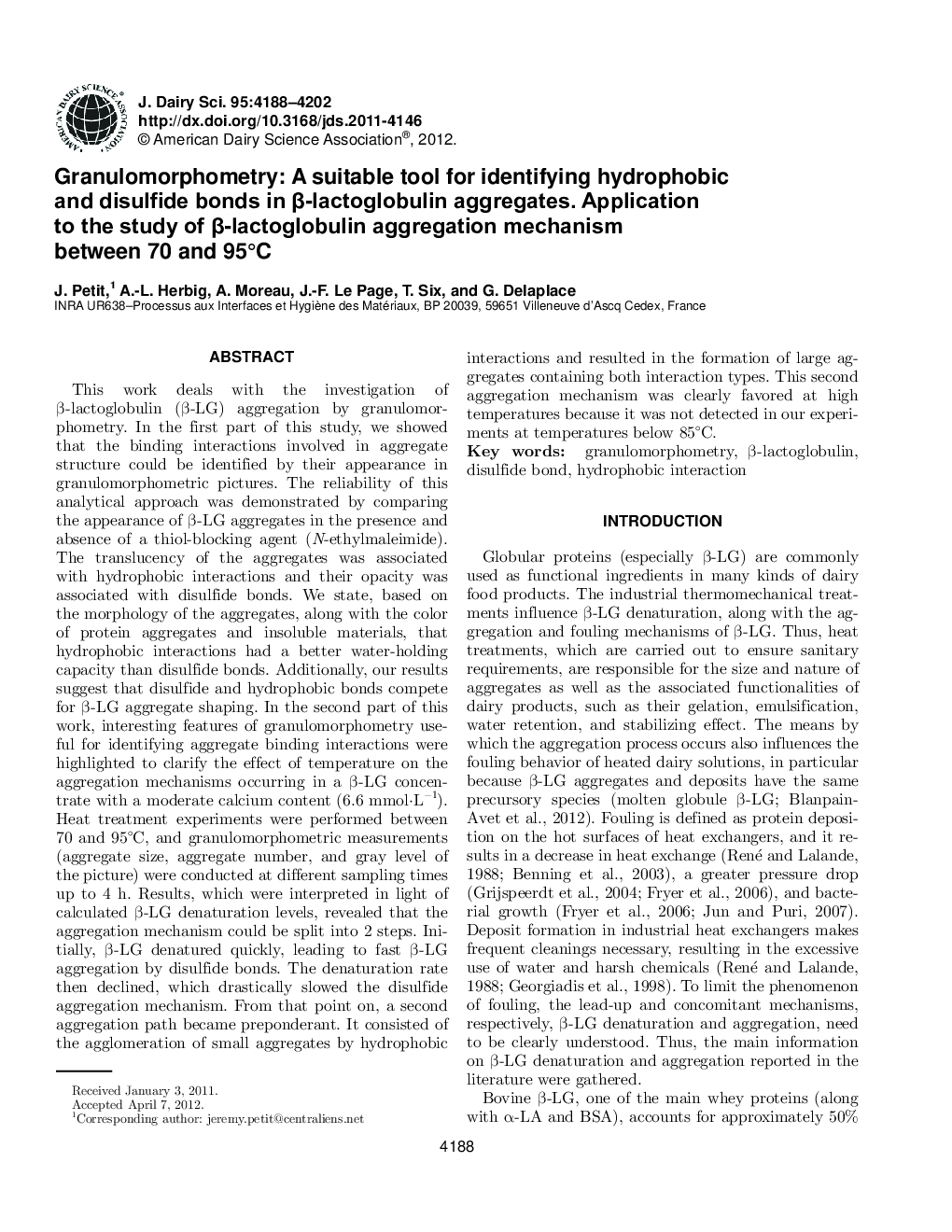| کد مقاله | کد نشریه | سال انتشار | مقاله انگلیسی | نسخه تمام متن |
|---|---|---|---|---|
| 10978780 | 1108060 | 2012 | 15 صفحه PDF | دانلود رایگان |
عنوان انگلیسی مقاله ISI
Granulomorphometry: A suitable tool for identifying hydrophobic and disulfide bonds in β-lactoglobulin aggregates. Application to the study of β-lactoglobulin aggregation mechanism between 70 and 95°C
دانلود مقاله + سفارش ترجمه
دانلود مقاله ISI انگلیسی
رایگان برای ایرانیان
کلمات کلیدی
موضوعات مرتبط
علوم زیستی و بیوفناوری
علوم کشاورزی و بیولوژیک
علوم دامی و جانورشناسی
پیش نمایش صفحه اول مقاله

چکیده انگلیسی
This work deals with the investigation of β-lactoglobulin (β-LG) aggregation by granulomorphometry. In the first part of this study, we showed that the binding interactions involved in aggregate structure could be identified by their appearance in granulomorphometric pictures. The reliability of this analytical approach was demonstrated by comparing the appearance of β-LG aggregates in the presence and absence of a thiol-blocking agent (N-ethylmaleimide). The translucency of the aggregates was associated with hydrophobic interactions and their opacity was associated with disulfide bonds. We state, based on the morphology of the aggregates, along with the color of protein aggregates and insoluble materials, that hydrophobic interactions had a better water-holding capacity than disulfide bonds. Additionally, our results suggest that disulfide and hydrophobic bonds compete for β-LG aggregate shaping. In the second part of this work, interesting features of granulomorphometry useful for identifying aggregate binding interactions were highlighted to clarify the effect of temperature on the aggregation mechanisms occurring in a β-LG concentrate with a moderate calcium content (6.6 mmol·Lâ1). Heat treatment experiments were performed between 70 and 95°C, and granulomorphometric measurements (aggregate size, aggregate number, and gray level of the picture) were conducted at different sampling times up to 4 h. Results, which were interpreted in light of calculated β-LG denaturation levels, revealed that the aggregation mechanism could be split into 2 steps. Initially, β-LG denatured quickly, leading to fast β-LG aggregation by disulfide bonds. The denaturation rate then declined, which drastically slowed the disulfide aggregation mechanism. From that point on, a second aggregation path became preponderant. It consisted of the agglomeration of small aggregates by hydrophobic interactions and resulted in the formation of large aggregates containing both interaction types. This second aggregation mechanism was clearly favored at high temperatures because it was not detected in our experiments at temperatures below 85°C.
ناشر
Database: Elsevier - ScienceDirect (ساینس دایرکت)
Journal: Journal of Dairy Science - Volume 95, Issue 8, August 2012, Pages 4188-4202
Journal: Journal of Dairy Science - Volume 95, Issue 8, August 2012, Pages 4188-4202
نویسندگان
J. Petit, A.-L. Herbig, A. Moreau, J.-F. Le Page, T. Six, G. Delaplace,